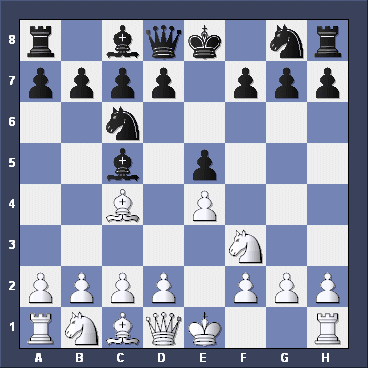
The ITALIAN GAME.
A very popular opening, especially with kids, and rightly so.
Learning this opening will help you win more games, so come on in!


|
It's time to learn another opening. The ITALIAN GAME. A very popular opening, especially with kids, and rightly so. Learning this opening will help you win more games, so come on in! 
|

|
Black's usual, and best, reply is Ng8-f6, to THREATEN the Pawn on e4. White can play safe with d2-d3, but it's more exciting to advance the Pawn two squares, giving this position. 
|

|
First, suppose Black retreats his Bishop: Bc5-b6.
White grabs a pawn - d4xe5, and Black does the same thing - Nf6xe4. What do you think White should play next?  




|

|
...reaching this position. White has a strong move in this position: can you find it?  




|

|
White must decide how to get out of check. He has two main options, a safe choice, and an exciting, but risky choice. Let's start with the safe choice, which is Bc1-d2. 
|

|
After Bc1-d2, Black usually chooses Bb4xd2+, giving this position. How do you think White should recapture?  Nb1xd2 Nb1xd2
 Qd1xd2 Qd1xd2 Ke1xd2 Ke1xd2
 Nf3xd2 Nf3xd2 

|

|
Now Black has to make a decision. What should he do about those center pawns?  Nc6xd4 Nc6xd4
 Nf6xe4 Nf6xe4 0-0 0-0
 d7-d5 d7-d5 

|

|
Here's the position, with White to move.
He starts with an EXPLOSION ON f7 OK, tell me the move.  




|

|
I hope you remembered this from the last lesson! Now White's got the King out, what does he do?  




|

|
Can you propose a move for White here?  




|

|
If you found the move, well played! But instead of Ne4xc3 Black should have played d7-d5, when he's a pawn ahead. 
|

|
What move did we play for White in this position?  




|

|
 




|

|
 




|

|
|